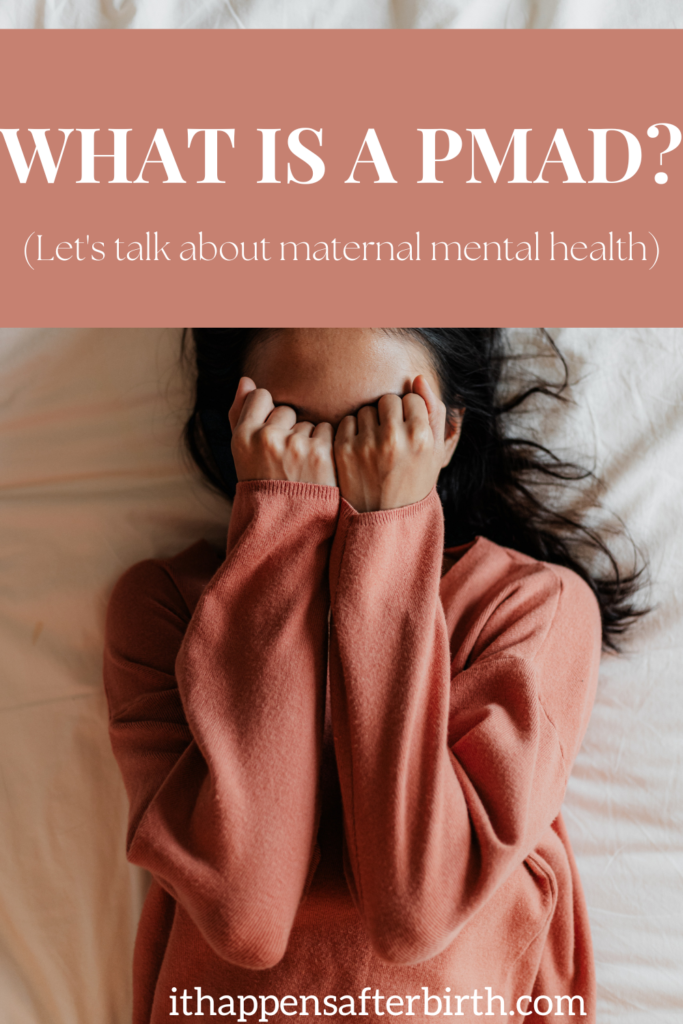Maternal mental health is becoming more recognized, but it’s no surprise if you’re left wondering “What is a PMAD?” Let’s talk about what a PMAD is and how we can help better the mental health of moms.

Maternal mental health- It’s a mouthful to say, but one of the most important conversations we can have.
What is a PMAD?
If you don’t know, it’s no surprise. I didn’t either- but then I began to delve into the world of childbearing and postpartum.
PMAD- Perinatal Mood and Anxiety Disorder
Perinatal covers the entire childbearing year, which means that you can get it either during pregnancy or after birth. After birth is going to be more common for parents to feel or talk about.
PMADs include:
- Postpartum depression
- Postpartum anxiety
- Postpartum OCD
- Postpartum PTSD
- Postpartum psychosis
Up to 20% of women will experience one of these mood disorders after giving birth. That’s one in every five women.
One in every five. Think about how many women, how many mothers, that each one of us knows. Five? Ten? Twenty? That could be up to five who struggled with a mood disorder- just out of the women that we know. It puts things into a whole different perspective.
That woman struggling could be me, or it could be you. It could be our best friend or sister. It could be any one of us, because mental health disorders do not discriminate.
Yes, there are risk factors. But it can happen to anyone. If that’s the case, then why isn’t it talked about more?
There’s a lot of stigma surrounding mental health, but especially when it comes to moms (or dads- they can get postpartum depression too). There’s this belief prevalent in the world that if you had a baby (more so if it is one you truly wanted), then you should be happy. Mental disorders should not only not be something that you struggle with, but they shouldn’t even be happening.
I would love if it were that easy to help each parent who is struggling right now. But telling someone, or telling yourself, to just choose happiness and get over it is going to make the problem worse. Not better.
Having a mood disorder after birth isn’t something that we choose.
However, it is something that happens. It’s something that can be treated, and it should never be gone through alone.
That’s why it’s important to end the stigma, talk about how common PMADs can be, and most importantly, learn to recognize the symptoms so that all of us can know when we need extra support. And so we can learn how to be that support to those who are going through it after us.
Postpartum depression
This is not to be confused with what’s commonly known as the baby blues. There’s some helpful charts out there on the internet which can explain the difference between the two, but the simplest explanation is that baby blues is a hormonal fluctuation which most women (up to 80%) will go through sometime in the first two weeks after birth. It will make you feel weepy, sad, irritable, and not like yourself. Typically, it will go away after a few days- six weeks at the latest.
Postpartum depression, on the other hand, might not start until after six weeks postpartum. It can happen anytime in the first year after giving birth. Symptoms can include:
- A change in your normal appetite or sleep pattern
- Weight gain or loss that is sudden or unexplained
- Feelings of hopelessness, anger, anxiety, guilt, or worthlessness
- Persistent feelings of sadness or emptiness
- Numbness or difficulty connecting with your baby or loved ones
- Loss of energy
- Suicidal thoughts
Postpartum anxiety
Postpartum anxiety is its own condition, though it may develop with postpartum depression. Most of the symptoms of depression and anxiety will overlap, which is why it’s hard to differentiate between the two. However, there are some symptoms of anxiety which depression does not have:
- Constantly worrying or feeling that something bad is going to happen
- Racing thoughts (which can also be known as intrusive thoughts)
- An inability to remain still
- Symptoms which may manifest physically, such as dizziness or nausea
Postpartum Obsessive-Compulsive Disorder (OCD)
This is a variation of anxiety, but less common. You don’t have to have been diagnosed with OCD prior to pregnancy in order to develop this after birth. Because it isn’t as common as either postpartum depression or anxiety, symptoms are not recognized or diagnosed as easily. Symptoms include:
- Intrusive thoughts- repetitive words or mental pictures that will not go away
- Doing certain tasks or behaviors over and over again, usually in relation to the baby or making fears go away. (Things such as counting baby items, cleaning, checking on your baby a certain number of times every night, etc.)
- Horror or disgust about these thoughts and behaviors, and knowing you can’t make them stop even if you want to
- Anxious feelings
- Afraid to be left alone with your baby
Postpartum Post-Traumatic Stress Disorder
This is another difficult one to diagnose, as these symptoms might not surface until years later. This condition also tends to last longer than any of the other postpartum mood disorders.
More often than not, trauma in birth or the immediate postpartum period (whether it’s real or perceived) is the cause of this condition. Events like:
- Unplanned cesarean section
- Life-threatening complications, such as prolapsed cord or postpartum hemorrhage
- Baby needing life-saving measures or a NICU stay
- Feeling a loss of control over birth
There isn’t a definitive guide specifically for postpartum PTSD, and in defining a case of PTSD the list of symptoms is quite long. But some to look out for could be:
- Negative memories of the event which are intrusive and reoccurring
- Nightmares
- Detachment
- Avoiding anything that reminds you of the event
- Increased feelings of anger
- Persistent irritability, sleeping difficulties, or hypervigilance
- Panic attacks
Postpartum Psychosis
This is the rarest of all the mood disorders- about 1-2 people in every thousand will get it. Symptoms will appear very quickly after birth, usually anywhere from 3-14 days. The symptoms are:
- Delusions
- Paranoia
- Difficulty sleeping
- Visual or auditory hallucinations (seeing or hearing things that are not real, or not actually there)
- Frequent thoughts of, or believing they need to, hurt themselves or their baby
- Mood swings
Postpartum psychosis is rare and also easily misunderstood. Women with a personal or family history of bipolar disorder (or a previous psychotic break) will be at a higher risk, but it can also be developed with zero risk factors.
While it is temporary, professional treatment needs to be given as soon as possible. Many women who experience postpartum psychosis don’t ever harm themselves or their infants, but studies have shown that there is about a 5% suicide rate and a 4% infanticide rate among those affected with the disorder.
What do I do if I have a PMAD?
Firstly, don’t blame yourself. It is never your fault if you develop any mood disorder after birth- they can happen to anyone, and they don’t discriminate.
Secondly, while it may be hard, the most important thing to do is to reach out for help and support.
Admitting to having a problem might feel the same as admitting that you’re a failure. It might feel like you’re saying that you’re not a good mother, or that you aren’t as strong as everyone else.
Lovely, none of those things are true. We all struggle. You might not know it until you finally feel brave enough to spill your troubles and for the first time hear someone say, “Yes, me too!” But we all do.
You may want to share first with your partner, a parent, or a very close friend. Reaching out to your care provider (doctor or midwife) or doula is another great way to find support or treatment. A church or spiritual support group is another good option.
There are even postpartum helplines to call, such as the one offered by Postpartum Support International.
After you have reached out to find initial support, there are many different options to choose for treatment that will fit your values and lifestyle. There is no shame in opting for treatments- the important thing is to help you feel well and whole again, however that comes about.
What if it isn’t me?
It can be so, so hard to watch a loved one struggle. It can be especially scary to see some of these symptoms start to show up in their life, and sometimes almost impossible to know how to talk to them about it.
I want you to know that it isn’t your fault that this is happening to your loved one, just as it isn’t their fault they’re developing a PMAD. There isn’t anything that anyone can do to prevent them from happening. And the fact that you recognize there is something happening, and want to help, is a fantastic first step.
You’re not going to be able to take care of it on your own- neither of you are. There are some practical ways to help, however.
- Offer a supportive, listening ear.
- Gently share some of the things you’ve been noticing (in a non-confrontational, non-judgmental way).
- Reassure them that you know it isn’t their fault, they are doing a great job, but you recognize they may need some help.
- Encourage and support them in any way they need and any treatment that they seek.
- Once they have a diagnosis, learn more about the specific PMAD they’re experiencing so that you can understand better what they’re going through and how to support them.
- Remember to take a breather yourself every now and again- you’re no good to support them if you’re getting burned out and exhausted.
Have you or anyone you’re close with ever experienced a PMAD? Share your story in the comments below.

